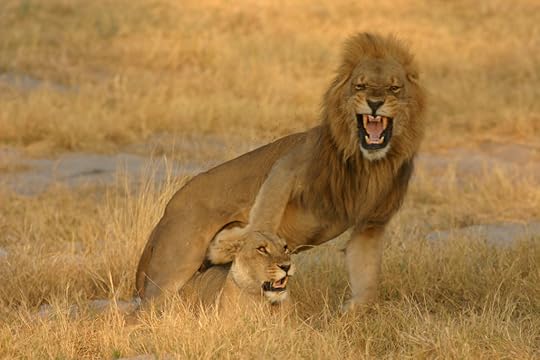Richard Conniff's Blog, page 42
September 15, 2014
Getting Too Close to a Wasp Nest
September 13, 2014
Useless Creatures (and Why They Matter)
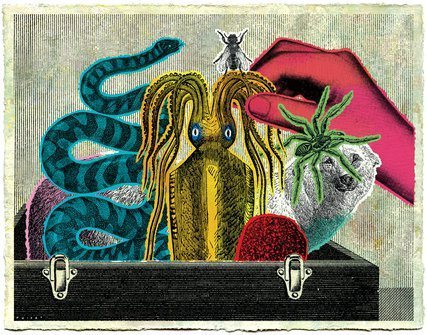
(Illustration: Chloé Poizat)
My latest for The New York Times:
This article contains no useful information. Zero. Nada. Nothing. If usefulness is your criterion for reading, thank you very much for your time and goodbye, we have nothing more to say. The truth is that I am bored to tears by usefulness. I am bored, more precisely, of pretending usefulness is the thing that really matters.
I mostly write about wildlife. So here is how it typically happens for me: A study comes out indicating that species x, y and z are in imminent danger of extinction, or that some major bioregion of the planet is being sucked down into the abyss. And it’s my job to convince people that they should care, even as they are racing to catch the 7:10 train, or wondering if they’ll be able to pay this month’s (or last month’s) rent.
My usual strategy is to trot out a list of ways even the most obscure species can prove unexpectedly, yes, useful. The first effective treatment that turned H.I.V. from a death sentence into a manageable condition? Inspired by the biochemistry of a nondescript Caribbean sponge. The ACE inhibitors that are currently among our most effective treatments for cardiovascular disease (and which have lately been proposed as a treatment for Ebola)? Developed by studying the venom of the fer-de-lance, a deadly snake found from Mexico to northern South America. The new medical bandage that’s gentle enough for the delicate skin of newborns and the elderly? Modeled on the silk of spider webs.
Every time I begin this line of argument, though, I get the queasy feeling that I am perpetuating a fallacy. It’s not that I’m telling lies; these examples are entirely real. But given, for instance, that three-quarters of our farm crops depend on insect pollinators, or that more than 2.6 billion people rely directly on seafood for protein, it seems a little obvious to be reminding people that wildlife can be useful, or, more to the point, that human survival depends on wildlife. Without saying so out loud, the argument also implies that animals matter only because they benefit humans, or because just possibly, at some unknowable point in the future, they might benefit humans.
You don’t have to look too far to see how silly this can get. In truth, I don’t have to look at all, because university press offices fill my inbox with examples every day: The Harvard scientists who hope their study of cuttlefish skin will “inspire improved protective camouflage for soldiers on the battlefield.” The Berkeley team that thinks studying the genetics of blubber-eating polar bears could help us learn to live with our bacon-wrapped, wide-load lifestyle. And the wonderful folks at Nanyang Technological University, in Singapore, who believe “Squid sucker ring teeth material could aid reconstructive surgery, serve as eco-packaging.” (And you thought they were good only for calamari.)
I don’t entirely blame the scientists. Their research often depends on taxpayer funding, and their dreams are haunted by the ghost of United States Senator William Proxmire’s Golden Fleece Award. That award garnered headlines by ridiculing outlandish-seeming items in the federal budget, and animal behavior studies were a juicy target. So now people doing that kind of research all feel obliged to imply that they are two steps away from a cure for the common cold. No basic research here, Senator, sir, no idle curiosity. Useful “R” Us. (They also delight in pointing out that one of Mr. Proxmire’s targets — a $250,000 investigation into the sex life of the screwworm fly — has yielded $20 billion in benefits to American cattle farmers by enabling control of a major insect pest.)
Improbably, wildlife conservationists now also often hear the call of the useful. Along with a large contingent of eco-finance bureaucrats, they try to save threatened habitats by reminding nearby communities of all the benefits they derive from keeping these habitats intact. Forests, meadows and marshes prevent floods, supply clean water, provide habitat for species that pollinate crops, put oxygen into the atmosphere and take carbon out, and otherwise make themselves useful. In some cases, conservation groups or other interested parties actually put down cash for these ecosystem services — paying countries, for instance, to maintain forests as a form of carbon sequestration. The argument, in essence, is that we can persuade people to save nature by making it possible for them to sell it. They can take nature to the bank, or at least to the local grocery. They can monetize it. (The new revised version of Genesis now says, “God made the wild animals according to their kinds, and he said, ‘Let them be fungible.’ ”)
I understand the logic, or at least the desperation, that drives conservationists to this horrible idea. It may seem like the only way to keep what’s left of the natural world from being plowed under by unstoppable human expansion and by our insatiable appetite for what appears to be useful. But usefulness is precisely the argument other people put forward to justify destroying or displacing wildlife, and they generally bring a larger and more persuasive kind of green to the argument. Nothing you can say about 100 acres in the New Jersey Meadowlands will ever add up for a politician who thinks a new shopping mall will mean more jobs for local voters (and contributions to his campaign war chest). Nothing you can say about the value of rhinos for ecotourism in South Africa will ever matter to a wildlife trafficker who can sell their horns for $30,000 a pound in Vietnam.
Finally, there is the unavoidable problem that most wildlife species — honey badgers, blobfish, blue-footed boobies, red-tailed hawks, monarch butterflies, hellbenders — are always going to be “useless,” or occasionally annoying, from a human perspective. And even when they do turn out, by some quirk, to be useful, that’s typically incidental to what makes them interesting. Cuttlefish do not fascinate because their skin may suggest new forms of military camouflage, but because of the fantastic light shows that sometimes play across their flanks. Spider web silk doesn’t intrigue because somebody can turn it into bandages, but because of the astonishing things spiders can do with it — stringing a line across a stream and running trotlines down the surface to catch water striders, for instance, or (in the case of the species named mastophora dizzydeani) flinging a ball of silk on a thread like a spitball to snag moths out of the air.
Wildlife is and should be useless in the same way art, music, poetry and even sports are useless. They are useless in the sense that they do nothing more than raise our spirits, make us laugh or cry, frighten, disturb and delight us. They connect us not just to what’s weird, different, other, but to a world where we humans do not matter nearly as much as we like to think.
And that should be enough.


September 12, 2014
In Mozambique, A Turning Point in the War on Elephants

Tusks seized in Niassa raid (Photo: WCS)
The arrest of a deadly six-man poaching gang this past Sunday in the Niassa National Reserve, on Mozambique’s border with Tanzania, could mark a turning point in the war on elephants for two African nations critical to the survival of the species.
In a 1 a.m. raid, the result of a 10-month-long investigation, local police together with wildlife scouts from Niassa and the adjacent Lugenda Wildife Reserve surrounded the gang members as they were transporting a dozen ivory tusks. The largest of the tusks, at 57 pounds apiece, came from an elephant believed to have been at least 40 years old. Police also confiscated two high-powered hunting rifles. During questioning, the shooter in the group, a skilled marksman, admitted to having killed 39 elephants in the Niassa Reserve this year alone.
That admission came in a bid to obtain repatriation to Tanzania, where four of the alleged poachers are based, according to Alastair Nelson, director of the Wildlife Conservation Society (WCS) Mozambique program, which co-manages the Niassa reserve with the national government. “But that’s not going to happen this time,” he said. “These guys are in prison now and we’re pretty confident they’re going to remain there. Mozambique’s new minister of tourism himself phoned the warden and asked that these men be tried under a new law passed June 20.”
That law, for the conservation of biodiversity, criminalizes poaching of endangered species. In the past, poachers often got off with a fine. But the new law now mandates a prison sentence of eight to 12 years, on conviction. That represents a major change for Mozambique, where in the run-up to elections last year, local police and politicians were rumored to be themselves participating in ivory poaching.
“We’re seeing a number of things beginning to align,” said Nelson. “We have had
intelligence before, but it hasn’t been so easy to act.”
Or to get the cooperation of local police. “Up to now, conservation and the environment have not been high up on the list of political priorities,” he added. “Mozambique is one of the 10 poorest countries in the world. But there’s more attention to the environment now, and tourism is moving up on the agenda, as well.”
The government also faces increasing pressure from neighboring countries, including Tanzania and South Africa, about poachers from Mozambique crossing the border to kill elephants and rhinos in those countries.
The pressure from Tanzania represents a major change. “In the past, there was extraordinary reluctance to even admit that there was a poaching problem,” a WCS biologist told Takepart last October, largely because the government was hoping to win international permission to sell its stash of almost 100 tons of confiscated ivory. But that effort failed, and at a UN-sponsored conference in May, Tanzanian Vice President Mohamed Gharib Bilal issued a plea for international help. With about 10,000 elephants being killed in Tanzania every year, conservationists predicted that elephants would be completely eradicated there in just seven years. Tanzania is scheduled to host another major elephant conference in November. “They’re now trying to take a leadership role” on the issue, said Nelson.
The Niassa Reserve is a huge wilderness, roughly the size of Tennessee, and in a 2011 survey, it was home to 12,000 elephants. But with 500 elephants killed by poachers this year alone, that number has almost certainly dropped. According to Nelson, the poachers arrested on Sunday represent just one of five gangs now working in the reserve. Asked if the arrest of relatively low-level poachers—shooters, porters, and poaching informants—would make much difference for Niassa, Nelson said, “This particular group is highly professional at what they do. That shooter has killed 39 elephants this year. He does this at night, using expensive hunting rifles, probably stolen, and that suggests that he’s brave and exceptionally good. This isn’t an ordinary low-end elephant poacher, and he has been working in Niassa for over a year. Another guy in the gang was the connection to the next guy up the chain. So they’re not that low down.”
“This work on the ground,” said WCS President and CEO Cristian Samper, who was in Niassa, “is part of a three-part strategy to stop the killing of elephants and stop the trafficking and demand for ivory. To solve this crisis, we need to focus efforts in Africa and on the other end of the supply chain in places such as China and the U.S.,” which ranks second in the illegal trade, largely because tourists continue to smuggle carved ivory knickknacks into this country from China.
The turning point in the war on elephants could be happening not just in Tanzania and Mozambique, but on a global scale. A march to urge more effective steps to protect elephants and rhinos takes place in cities around the world on October 4. And just this week, in Proceedings of the National Academy of Sciences reports that African elephants have now reached a tipping point, where more animals are being killed each year than are being born. With the population heading down at a rate of three percent a year, extinction in the wild of the Earth’s largest land animal has become a dismaying possibility.


September 5, 2014
It’s Not Just Deforestation, it’s Degradation. And Wildlife Loses

Black bear meets dragonfly (Photo: Reuters)
Deforestation—the worldwide destruction of forests—is the calamitous problem that everybody worries about. But a new analysis makes the case that forest degradation is also happening at “alarming speed” and may be just as bad, particularly for wildlife.
Just since the year 2000, almost 250 million acres of the world’s last remaining undisturbed forests have become degraded, mostly by logging and new roads, according to the analysis, the first attempt to measure forest degradation on a global scale. That’s more than triple the land area of Germany, and represents eight percent of the world’s remaining “Intact Forest Landscapes,” or IFLs.
Ilona Zhuravleva, a Greenpeace GIS scientist who worked on the analysis, said forest degradation poses a major threat to some of the most charismatic animals on Earth, particularly large, wide-ranging species that depend on genuine wilderness for their survival. Among the victims are forest elephants in the Congo, jaguars in the Amazon, woodland caribou in Canada, wolves and bears in Russia, and tigers in Asia. Indigenous forest people also typically become displaced, or worse, when industrial forestry brings the outside world into formerly inaccessible regions.
In the worst case cited in the study, the South American nation of Paraguay has already lost 78 percent of its remaining undisturbed forests in this century, largely because it failed to regulate cutting of its Chaco forests to make room for soybean farming and cattle ranching. That has allowed “U.S.-based agribusiness giants Cargill, Bunge, and Archer Daniels Midland to aggressively expand in Paraguay with a minimum of international scrutiny or outcry,” Rolling Stone recently reported.
Among the other examples of degradation cited by the researchers, Russia has recently permitted industrial forestry in the Dvinsky Forest, 540 miles north of Moscow, degrading about a quarter of one of Europe’s largest remaining intact forest landscapes. The Republic of the Congo (not to be confused with the war-torn Democratic Republic of the Congo) has likewise degraded 17 percent of its intact forests in this century. In both Russia and the Congo, according to the analysis, the degradation was the work of companies that had at one time been certified as sustainable by the Forest Stewardship Council (FSC).
The announcement of the new analysis, by a consortium of university and environmental groups, comes just ahead of the FSC’s triennial General Assembly, beginning Sunday in Seville, Spain. The FSC certifies sustainable forestry practices on 180 million acres of forest, about 15 percent of all forests worldwide. But according to Christoph Thies of Greenpeace International, much of the degradation is taking place on intact forests certified by FSC.
“We need to alert them that they have an implementation problem here, and if they want to be credible,” he said, they need to take the issue of forest degradation seriously. Thies, who belongs to the FSC’s environmental chamber, said that should mean an end to cutting new roads into the world’s last remnants of forest wilderness.
Forest degradation can be extraordinarily difficult to detect, said Peter Potapov, of the University of Maryland. Hence most previous studies have not even attempted to look at the issue at the national level, focusing instead on regional or even local areas.
For this study, the researchers relied on imagery provided by the U.S. Geological Survey Landsat program in partnership with NASA. They took baseline satellite imagery of large Intact Forest Landscapes from the year 2000, and then scrutinized 2013 satellite images of these IFLs for signs of new roads, logging, mining, oil and gas exploration, agriculture, and fires near human infrastructure.
The combination of satellite imagery with “ever more powerful cloud computing” could make it easier to track and even prevent forest degradation in real time. (The maps used in the analysis are available at the Global Forest Watch website for analysis by others.) “We believe, said Potapov, “that the global IFL map will help to spur practical conservation planning and action,” leading responsible logging companies to leave large undeveloped forest landscapes intact.
If that doesn’t happen, said Nigel Sizer of the World Resources Institute, what the new analysis makes clear is “that business as usual will lead to destruction of most remaining intact forests in this century.”
And some of the most beloved animals on Earth will vanish in the process.


September 2, 2014
How a Fraction of Farm Subsidies Could Save 10,000 Species
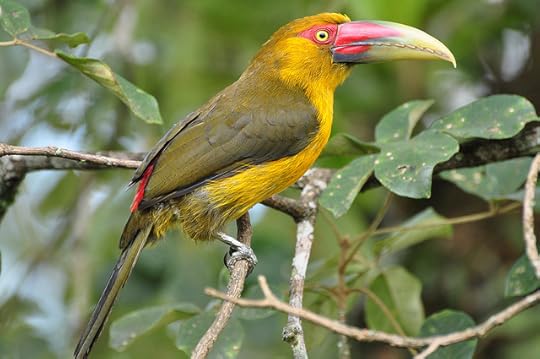
Saffron toucanet
If Brazil shifted just 6.5 percent of its present agricultural subsidies to reforestation, it could save its precious Atlantic Forest–and incidentally benefit farmers, by improving pollination and pest control. Here’s the press release from the Imperial College London:
Brazil could conserve its valuable Atlantic Forest by investing just 0.01 per cent of its annual GDP, according to a new study.
The Atlantic Forest (Mata Atlântica) is one of the most important and threatened biodiversity hotspots in the world, containing the only living examples of nearly 10,000 species of plant and more bird species than all of Europe.
Situated along the Atlantic coast of Brazil, it once covered an area of nearly 1.5 million square kilometres. Today, the forest is home to more than 130 million people and it covers only 160,000 km2, because of deforestation.
Reporting in the journal Science, a team of international scientists have calculated that it would cost US$198 million per year to pay private owners to set aside land for reforestation. Together with the conservation of existing tracts, this would be enough
to conserve the majority of species and many of the benefits that come from the forest’s ecosystem, such as pest control and pollination.
US$198m is equivalent to only 6.5 per cent of what Brazil already invests in agricultural subsidies and less than 0.01 per cent of the country’s annual GDP.
There are already some schemes in Brazil to pay private land owners to set aside land to conserve the forest, preserve species and maintain healthy ecosystems, but these have been local-scale initiatives that have had little impact on maintaining and improving the conditions of the forest as a whole.
Lead researcher Dr Cristina Banks-Leite, from the Department of Life Sciences at Imperial College London, said: “The Atlantic Forest is smaller and far more degraded than the Amazon rainforest, but it is also contains a vast range of biological diversity. The forest is a crucial habitat that is home to more than half of Brazil’s threatened animal species. At the moment, outside of protected areas, nearly 90 per cent of the Atlantic Forest has less than 30 per cent of forest cover remaining. This is quite simply not enough to ensure the survival of species and maintenance of a thriving ecosystem across rural areas.”
“Our study shows that it would be relatively cheap to secure the future of the forest — and protect its plants, birds and other animals — by paying land owners on a large scale to set aside land for conservation. Local communities and land-owners will benefit not only from regular payments but also from the benefits that a flourishing ecosystem brings. We need to start to put such a scheme in place now, before it becomes too late.”
In this new study scientists calculated how much it would cost to set aside land in priority landscapes across the whole Atlantic Forest in order to restore the minimum amount of habitat needed to conserve biodiversity and maintain ecosystem functions. Their findings reveal:
At least 30 per cent of native habitat needs to be preserved to maintain current levels of biodiversity
It would cost US$198 million per year, for the first three years, to set aside and reforest enough land to a minimum of 30 per cent forest cover.
This is the equivalent of 0.0092 per cent of Brazil’s annual GDP, a figure that would reduce to 0.0026 per cent once active restoration costs are no longer needed.To calculate costs the researchers first had to record what and how many species are currently living in pristine and degraded areas of the Atlantic Forest.
Over a period of nine years, a team of more than 100 researchers led by Dr. Renata Pardini, Dr. Marianna Dixo and Prof. Jean Paul Metzger from the University of São Paulo, collected data on birds, mammals and amphibians living in the forest. Using mist nets to capture birds as well as pitfall traps to capture mammals and amphibians, they painstakingly recorded information on 25,000 individuals, made up of 140 species of birds, 43 species of mammals and 29 species of amphibians.
They collected data in 79 different forest regions across 150 kilometres and estimated that to maintain a similar level of biodiversity and ecosystem functions, which are found in protected areas such as national parks.a minimum of 30 per cent of native habitat needs to be preserved.
To evaluate overall costs of maintaining minimum forest cover the scientists combined current estimates of existing forest cover with average costs paid to private land owners, and found that preserving the forest is feasible and low-cost.
Prof. Jean Paul Metzger from the University of Sao Paulo, another lead author of the study, said: “Our study shows a clear threshold of biodiversity losses with deforestation; below this threshold, not only many species disappear, but the functions they perform in the ecosystem will also decline, many of which are highly beneficial to humans. This threshold is important to identify win-win situations where both agriculture production and biodiversity conservation is optimized. Furthermore, this information can be a practical tool for planning sustainable landscapes, and should be incorporated into different land use policies, such as the Brazilian Forest Code, programs for ecosystems payments or in socio-environmental certification incentives.”


August 29, 2014
How to Catch Piranhas with Your Bare Hands
I’ve caught and eaten piranhas (they’re tasty), but never quite like this.
Nice that she doesn’t get a manicure in the process.


August 28, 2014
Abundant in the 1990s, Monarch Butterflies Now at Risk of Extinction

Monarch butterfly (Photo: Kristofer Rowe)
With Labor Day just ahead, people on both coasts and across the Great Plains should be celebrating the start of one of North America’s great migrations. The spectacle of monarch butterflies working their way back to their overwintering sites, across hundreds or thousands of miles, is the longest known insect migration on Earth.
It’s such a popular event, and the monarchs are so beautiful—their brilliant orange wings bordered with a black-polka-dot hem—that seven states have named monarch butterflies their state insect.
But this year the parade is mostly canceled, and instead environmental groups have petitioned the United States Fish and Wildlife Service to list the monarch butterfly as a threatened species.
The monarchs have been decimated—populations are down 90 percent from their 20-year average. That’s “a loss so staggering,” said Tierra Curry, a senior scientist at the Center for Biological Diversity, “that in human-population terms it would be like losing every living person in
the United States except those in Florida and Ohio.”
As it happens, that’s putting it conservatively. From its peak of a billion individuals in the mid-1990s, the monarch butterfly population is down to an estimated 35 million now, a 97 percent decline.
Last winter’s population count at the butterfly’s overwintering site in Mexico was the lowest ever recorded. That’s what pushed the Center for Biological Diversity, the Center for Food Safety, the Xerces Society, and the renowned butterfly biologist Lincoln Brower to file their joint petition this week, according to Curry. That number—35 million—may sound like plenty of butterflies to opponents of the Endangered Species Act. But the fatal tendency in the past, said Curry, has been to withhold protected status for butterflies until they are on the brink of extinction. When FWS listed the Miami blue butterfly as an endangered species in 2012, for instance, the population was down to fewer than 50 individuals.
Sarina Jepsen, endangered species director at the Xerces Society, noted that this is the 100th anniversary of the death of the passenger pigeon Martha, the last of another species once considered too numerous to become extinct. “History demonstrates that we cannot afford to be complacent about saving the monarch,” she said.
The listing petition blames the decimation of monarch butterflies largely on the practices of a single American corporation, Monsanto, which bills itself “a sustainable agriculture company.” Its introduction of genetically modified herbicide-tolerant soybeans in 1996 and corn in 1998 resulted in a 20-fold increase in use of its Roundup weed killer by American farmers, according to the petition. As a result, the milkweed on which monarch butterflies depend vanished from a vast area in the Midwest. The weed killer, together with other developments, has since destroyed 167 million acres of monarch butterfly habitat (an area the size of Texas), according to the petition.
For Monsanto, which is accustomed to being called “the most hated company in America,” this may not be quite as bad as being caught dressing up in Wehrmacht uniforms and killing puppies. But its role in the demise of the monarchs could yet become a public relations nightmare. Earlier this year, Monsanto suggested on its blog that the blame lies more with loss of wintering habitat in Mexico. But the company also said it’s “eager to join efforts to help rebuild monarch habitat” and “to increase milkweed populations on the agricultural landscape.” So far, according to those close to the issue, that has meant attending meetings but without offering specific action or financial investment.
In an interview, Brower noted that Monsanto can afford to make a difference. (It reported $4.25 billion in third-quarter sales, and surging profits on weed killers.) The quickest way to get results, he suggested, would be to plant milkweed on highway margins and power-line rights of way, and to create no-weed-killer buffer zones on the margins of agricultural fields.
“We don’t see farmers as the problem,” said Tierra Curry. “We see farmers as part of the solution.” The Conservation Reserve Program, under which the government pays farmers to leave some land fallow, could become a means for rebuilding milkweed stands, she said, though Congress has recently been cutting back on the amount of eligible acreage. She also suggested reducing or eliminating ethanol subsidies, which have vastly increased the amount of land devoted to corn, and instead subsidizing farmers to plant milkweed.
Individuals concerned about the catastrophic decline in monarch butterflies can help by planting milkweed, she said. But it should be a milkweed species suitable to your area. (Here’s a list of suppliers.) It might also help to write a letter to Monsanto CEO Hugh Grant at the company’s headquarters—800 N. Lindbergh Blvd., St. Louis, MO 63141—and to sign a public petition asking the FWS to protect monarch butterflies.
That agency has three months to decide if there’s evidence for a reasonable person to believe monarch butterflies are in danger of extinction. If it agrees, it then has a year to research the issue. But the process typically drags on for three years and sometimes more than 10.
By then, at the current rate, there may not be any monarch butterflies left to protect.


Africa’s Senseless War on Vultures
(Illustration: Sophy Hollington)
I ran into this senseless war on vultures during my recent visit in South Africa, where the preferred poison is known popularly as “Two Step.” Good to see the issue getting play in The New York Times, in this op-ed by conservation biologist Darcy L. Ogada:
NAIROBI, Kenya — IN July of last year, roughly 500 vultures died after they ate the pesticide-laced carcass of an elephant that had been killed by poachers in Namibia. It was an example of one poaching technique in Africa that seems to be on the rise: the poisoning of vultures so that authorities won’t be alerted to the location of the crime.
The overhead circling of vultures has long been used to locate lost or dead livestock. In the same way, vultures help law enforcement officers zero in on poachers.
With their keen eyesight and distinctive vantage point, vultures can locate an elephant carcass within 30 minutes of the animal’s death. It can take 45 to 70 minutes for the most skilled poachers to hack off two elephant tusks, and when vultures gather overhead rangers can get that much closer to apprehending the perpetrators. By poisoning a carcass and killing vultures en masse, poachers are trying to ensure that next time around there will be fewer of them to contend with.
Vulture conservationists began to take particular note of this development in July 2012, when an elephant was poached in Gonarezhou National Park in Zimbabwe and 191 vultures were found scattered around the carcass, poisoned. Since then …
Read the full story here.


August 25, 2014
Splendor in the Grass? Lions on a Very Hot Date

(Photos: Dave Hamman)
The photographer Dave Hamman took these photos of lions in flagrante delicto. I was immediately reminded of Lord Chesterfield’s remark about sex: “The pleasure is momentary, the position ridiculous, and the expense damnable.”
At least in this case the female maintains a certain decorum.
Or maybe she’s just bored.
The male meanwhile seems determined to make the King of the Jungle look pretty goddamned silly.
Then he says, “That was good for me, was that good for you? Oh, never mind, gotta run,” and gets the hell out of there as fast as he can.
The scene was Chitabe, in Botswana’s Okavango Delta.


The Best Place on Earth to See Wildlife
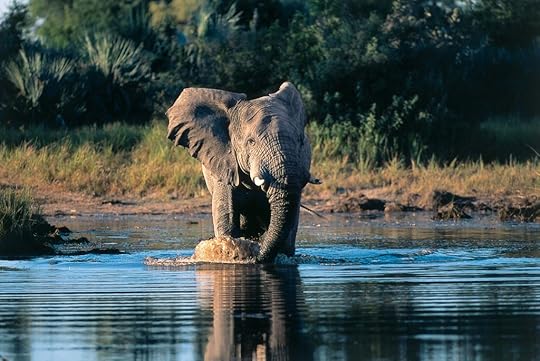
Chitabe Camp regular (Photo: Dave Hamman/Wilderness Safaris)
When people ask me, “What’s the best place in the world to see wildlife?” I generally say, “Wherever you happen to be right now. Just look.” They nod politely. After a second they add, “OK, and if I want to travel?” The obvious possibilities come to mind—the rainforests of Costa Rica, Tanzania’s Serengeti National Park—along with a few quirkier ones, such as Los Llanos in Venezuela and the Himalayan foothills in Bhutan. In the end, though, I always answer: the Okavango Delta in Botswana.
The trouble is, I can’t always remember why.
But the other week I was back, on an unexpected side trip from South Africa, and suddenly I knew. It was 6 a.m. and cold (it’s winter there), and we were out in an open Land Rover in an area called Chitabe, as the thin red line of sunrise widened and turned mauve behind a distant line of acacia trees. Now and then, the driver, a photographer friend named Dave Hamman, pulled over to inspect tracks on the road, or turned off the engine to listen for the alarm calls of baboons or francolins, the telltale signs of a predator nearby.
Maybe it was the pungent smell of the sagebrush sweeping down the sides of the vehicle, or just the tantalizing uncertainty of being out on the hunt, but it all came back to me. The sunrise faded to a grayish blue, and we picked up the tracks of four big male lions that had wandered the road a little earlier
in the morning. But we were more interested in the smaller predators lions tend to intimidate—leopards, cheetahs, and African wild dogs.
Hamman, who has spent much of the past 20 years in the delta, pointed out a couple of giraffes with ears cocked, as if they were noticing something we might want to see. But it didn’t pan out, and after a while, he complained mildly about our poor luck. Meanwhile, I was ticking off the incredible list of wildlife we passed by: the glossy ibis, the fish eagle, the saddle-billed stork with a red bill and a patch of pure yellow just in front of the eyes. The black-winged stilts wading in shallow water, their pink legs lifting high up behind on each step, with an exaggerated movement, as if being drawn back from a tub that’s a little too hot. A spur-winged goose came in for a landing, more like a crash, ending in a graceless kerplunk. “Tough bird,” said Hamman. “Around here they say you put one in a pot with three rocks, cook it for four days, then throw away the bird and eat the rocks.”
Then there were the ungulates—not just the impalas, which are every predator’s favorite fast food, but also big moose-like tsessebes, which can run for bursts of 50 miles an hour, and lechwe, which seem to be able to run on water (a useful trait in a delta). A solitary Cape buffalo stared at us malevolently—“They look at you like you owe them money,” said Hamman—escorted by cattle egrets and oxpeckers.
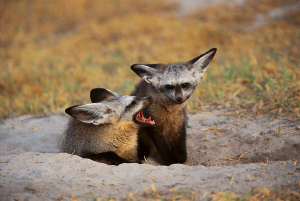
Bat-eared foxes (Photo: Wilderness Safaris)
It reminded me of what I like so much about the Okavango Delta: It doesn’t matter what species you think you’re looking for, because something else at least as interesting almost always turns up along the way.
Water is the secret that attracts such a diversity of wildlife to the Okavango Delta. Every year in January and February, the rains come rushing down from the highlands of Angola, across Namibia’s Caprivi Strip, and into Botswana, where they spread out across an ancient lake bed roughly twice the size of Massachusetts. Grasses and marshlands and meandering waterways spring up, meaning food for everyone.
If the water gets too high, the wildlife often crowd together in improbable but scenic groups. On one hillock by a watering hole I saw, in a single binocular view, yellowbill storks, openbill storks, a slaty egret, a squacco heron, a sacred ibis, and a smallish crocodile, maybe eight feet long, all standing together like commuters waiting for a bus.
In a jackalberry tree, the starlings were gabbling over their meal, while a lilac-breasted roller, all raspberry sherbet at the breast and bright blue below, perched on the perimeter, content to do nothing more than look stunning, an ornithological popsicle. Beneath the trees, a hungry elephant tore up the understory.
If it sounds like the Garden of Eden—and in truth it feels like that—the Okavango Delta also faces the usual threats. Countries to the north want to capture the river flow for a hydropower project, and Botswana has a knack for putting up veterinary fences, which protect its cattle industry at the cost of confusing and killing its migratory wildlife. Subsistence livestock herders and farmers along the delta’s eastern border sometimes poison wildlife or sicken it with the diseases their dogs introduce.
But for now the Okavango Delta is there, largely intact and endlessly beautiful. I’m still going to tell people that the best place to see wildlife is at home, where you can get to know it over months and years and maybe do something to protect it. But I’m not going to lie. I’m back home now and dreaming of the Okavango Delta. It seems to me that the best thing I can do is celebrate this place and encourage other people to visit, if only to remind Botswana and its neighbors that they are the guardians of one of the earth’s great treasures.







